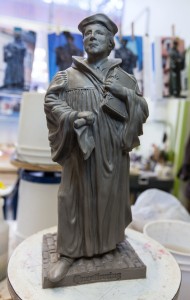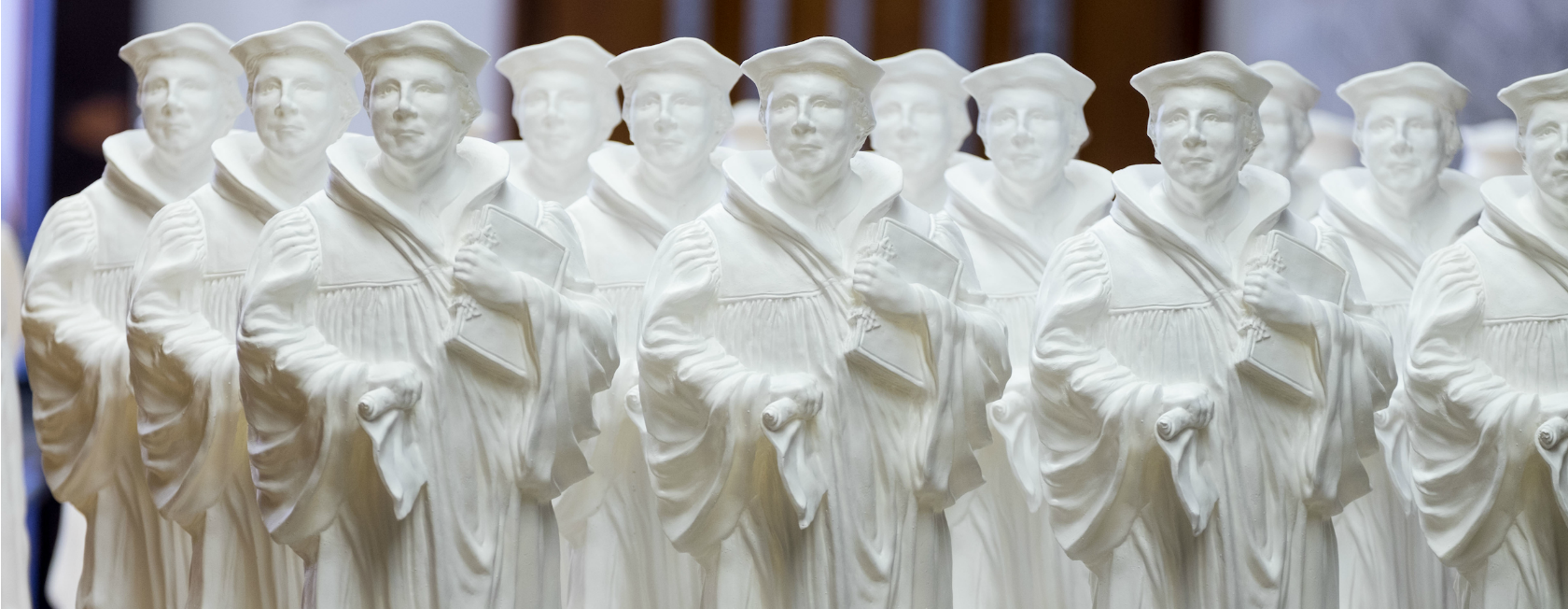Martin Luther comes to life
By Kate Hall '18 and Mandi LeCompte
Making Marty is no easy task.
Spencer Ebbinga, associate professor of art and design, has been busy working on a special project: 17-inch statues of Martin Luther. These colorful gems are hidden around campus as part of PLU’s Marty’s Reformation Station, which celebrates the 500th anniversary of the Reformation. Students with the Marty App (free to download) participate in a scavenger hunt for facts about Martin Luther.
How long did the process of creating Marty take from start to end?
Ebbinga: From start to finish it was 399.5 hours over the course of 48 days.
What was the most difficult part of this extensive process?
Ebbinga: The most difficult part, or perhaps most time-consuming part, was learning a slush-casting method that worked well for this particular mold. Slush-casting is a process that involves putting a liquid into either an open mold or a closed mold, and slushing the material around so that all parts receive an even coating before the material hardens.
Perhaps a good analogy would be making crepes. The batter goes into the pan and you slush it around to distribute it evenly as it cooks. This is a simple process if your mold is symmetrical with even surfaces; however, this was not the case for this sculpture. It took about nine castings before I figured out a good method and technique for attaining the desired outcome. Due to the toxicity of the raw materials, this step needed to be completed while wearing a respirator, which makes any physical process more uncomfortable.
How was this project similar to or different from other projects you’ve completed for the university, including busts of Karen Hille Phillips and former PLU president Loren Anderson?
Ebbinga: This project was very similar in the initial stages: sculpting the form in clay, creating a mold and mother mold to hold the material, and then slush-casting. The primary difference was the casting materials. Plastic is so much simpler to work with than bronze and can be accomplished without the foundry process.
Once cast, both materials need to be “chased,” a process of grinding, sanding, and working back imperfections in the casting to achieve the desired surface. Where metal requires a wide range of heavy tools, plastic can be chased with simple files. The other main difference was the amount of forms created. There were only two bronze busts, but to date there have been 39 plastic castings.
Do students learn about this process in your classes?
Ebbinga: It is a process I have taught, although with less toxic and more affordable materials. Mold making provides fantastic lessons in creative problem solving as each mold offers different challenges and requires its own solutions. The principles of how a mold is constructed remain fairly constant depending on the material to be cast. A significant hurdle in teaching these processes is the cost and amount of waste generated when a mold doesn’t perform as intended. It means that the original attempt needs to be successful for the most part, and doesn’t allow for a lot of tests and trials like you might find in a ceramics course. 3D digital modeling and printing are quickly replacing a lot of casting in art and industry as a method of replication, but the lessons are still relevant and provide a wide range of knowledge and application in many disciplines from cooking to aerospace.
Tell us a bit about your journey as an artist. How did you discover your vocation?
Ebbinga: According to my parents I have been a creator since I was able to squish play dough. I find the most satisfaction, and learn more readily, when I am using my hands in concert with my brain and heart. My best classes all throughout my primary and secondary education were art and shop classes, or courses that had some creative hands-on component. My father, a Lutheran pastor, was also a craftsman and amateur artist, creating everything from furniture to great welded steel monstrosities. There were always opportunities to hold, sand, weld or fix something in the garage.
In high school, my parents enrolled me in drawing and painting classes at one of the local community colleges, and it was all of these experiences that eventually led me to the art department at the University of Kentucky. I graduated with a Bachelor of Fine Arts degree with an emphasis in ceramics and sculpture, and later went on to receive a Master of Fine Arts in sculpture from Arizona State University. I was hired as an assistant professor of art at PLU 10 years ago, and have been making gigantic messes ever since!





Social Media